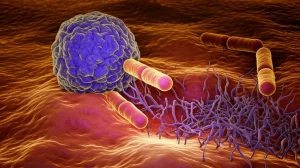Hitting Cancer Where It Hurts: A Triple-Whammy Attack on a Nasty Pathway
Alright, let’s talk about something that’s a real game-changer in the world of cancer research. We’ve been looking at this super important pathway in our cells called the PI3K/AKT/mTOR pathway. Think of it as a major control hub for how our cells grow, multiply, and decide whether to stick around or, well, not. It’s like the main switchboard for a cell’s metabolism, sensing when there are enough nutrients and growth signals to go full steam ahead with making proteins and dividing. Super important stuff for normal biology, right?
But here’s the kicker: when this pathway goes haywire, it’s often bad news, especially in cancer. Mutations that switch this pathway into overdrive are some of the most common troublemakers we see in various cancers. And when I say common, I mean really common. For instance, in hormone-sensitive cancers like endometrial and breast cancer, this pathway is mutated like crazy. About 80% of endometrial cancers have some kind of mutation in this pathway! Yet, surprisingly, there aren’t any approved targeted drugs for endometrial cancer that go after this pathway specifically.
The Problem with Hitting Just One Target
Now, you might think, “Okay, if the pathway is overactive, just block it!” And that’s what researchers have been trying to do with what we call single-node inhibitors (SNIs). These drugs target one specific point in the pathway. We’ve got a few approved for breast cancer, like alpelisib and inavolisib (targeting PI3Kα), capivasertib (targeting AKT), and everolimus (an mTORC1 inhibitor). But honestly, their success has been a bit…meh. They offer modest benefits, and there are good reasons why.
Imagine you’re trying to stop a river by damming just one small tributary. The water (or in our case, the cancer-promoting signals) often finds a way around. That’s what happens with SNIs. Here are the main headaches:
- Feedback Reactivation: The pathway is clever. You block one part, and it often re-routes signals or even ramps up other parts to compensate. It’s like a cellular game of whack-a-mole. For example, blocking one node can inadvertently turn off negative feedback loops, leading to other growth signals, like ERK signalling, getting a boost.
- Co-occurring Mutations: Cancer cells are notorious for having multiple mutations. So, even if you target the PIK3CA gene (which codes for PI3Kα, a frequent culprit), there might be other mutations further down the pathway that keep it active.
- Systemic Shenanigans: Some of these drugs mess with the body’s glucose control. This can lead to high blood sugar (hyperglycaemia) and high insulin (hyperinsulinemia). And guess what? Insulin is a primary activator of the PI3K pathway! So, the drug itself can inadvertently create conditions that reactivate the very pathway it’s trying to block. Talk about a Catch-22!
Researchers have tried developing mutant-specific PI3Kα inhibitors to spare normal cells and avoid the glucose issues, but these still suffer from the other SNI limitations. Clearly, we needed a smarter strategy.
Enter the Multi-Node Attack: A Triple Threat
So, what if instead of hitting one spot, we hit multiple key nodes in the pathway simultaneously? That’s the idea behind a multi-node inhibitor (MNI) approach. And let me tell you, the results we’ve been seeing are pretty exciting!
We’ve been focusing on a combination of two drugs: sapanisertib (which targets both mTORC1 and mTORC2 – two crucial complexes in the pathway) and serabelisib (a PI3Kα inhibitor). The idea is to deliver a more comprehensive shutdown. And to tackle that pesky hyperinsulinemia issue, we also threw in an insulin-suppressing diet (ISD) into the mix for some of our studies.
We tested this strategy in models of endometrial and breast cancer, and boy, did it make a difference. We looked at how well this combo suppressed those pathway signals (specifically, the phosphorylation of proteins called S6, AKT, and 4E-BP1, which are like little green lights telling the cell to grow).

The serabelisib-sapanisertib combo was way better at shutting down the PI3K/AKT/mTOR pathway signals, especially for 4E-BP1, compared to a whole bunch of SNIs we tested. This included approved drugs like alpelisib and everolimus, and even some newer mutant-specific PI3K inhibitors like RLY-2608 and STX-478. It was like night and day!
Why Targeting 4E-BP1 Seems to be Key
It turns out that really knocking down the activity of 4E-BP1 seems to be crucial. While many SNIs could reduce S6 phosphorylation (a sign of reduced pro-growth signalling), they often struggled to do much about 4E-BP1. Sapanisertib, by hitting both mTORC1 and mTORC2, did a much better job with 4E-BP1. But when we combined it with serabelisib? Chef’s kiss! We saw the most complete pathway inhibition, even in cancer cell lines that had two or three different mutations in the pathway.
What’s so special about 4E-BP1? Well, S6 is more about controlling cell size, while 4E-BP1 is more directly linked to cell proliferation – the actual dividing and multiplying of cells. 4E-BP1 controls a critical step in making new proteins, so if you can effectively block its function, you put a serious brake on cancer growth. In fact, we found a strong correlation: the better a drug combo was at inhibiting 4E-BP1 phosphorylation, the more potent it was at stopping cancer cell growth (lower IC50 values, which means you need less drug to do the job).
Teamwork Makes the Dream Work: Combining with Other Therapies
Cancer treatment is often about combination therapy, so we wanted to see how our sapanisertib-serabelisib dynamic duo played with others. Good news! It combined effectively with a range of other treatments used for endometrial and breast cancer, including:
- Chemotherapies like carboplatin and paclitaxel
- Hormone-targeted therapies like fulvestrant and elacestrant
- CDK4/6 inhibitors like palbociclib
- Even an emerging drug called selinexor
In our lab tests, adding sapanisertib and serabelisib made these other drugs work even better, shifting the dose-response curves in the right direction (meaning more cancer cell killing at lower doses). We didn’t see any signs of them getting in each other’s way, which is super important.
Overcoming Paclitaxel Resistance: A Nasty Foe
Paclitaxel is a common chemotherapy, but cancer cells can become resistant to it. We were curious about what happens in those resistant cells. So, we created some paclitaxel-resistant endometrial cancer cell lines in the lab. And guess what we found? These resistant cells had actually ramped up their PI3K/AKT/mTOR pathway activity! It was like they were using this pathway to fuel their resistance.
But here’s the cool part: even though they were resistant to paclitaxel and had this hyperactive pathway, they were still sensitive – or in one case, even more sensitive – to our sapanisertib-serabelisib combination. Our MNI approach could still shut down the pathway effectively in these tough, resistant cells. This is a big deal because it suggests this combo could be useful even when other treatments have failed.

Taking it to the Next Level: Animal Models and the Power of Diet
Lab dishes are one thing, but what about a more complex system? We moved on to xenograft models, where human cancer cells are grown in mice. Here, we tested sapanisertib, serabelisib, and paclitaxel, both as single agents and in various combinations. We also looked at the impact of that insulin-suppressing diet (ISD).
The results were pretty striking. As single agents, sapanisertib and serabelisib showed good activity. The combination of sapanisertib plus serabelisib was even better, causing near-complete tumor growth inhibition in one of the breast cancer models. Paclitaxel also worked, but in some cases, our MNI drug combo was more effective than paclitaxel alone.
When we combined sapanisertib and serabelisib with paclitaxel (the “triplet” therapy), even at lower doses of paclitaxel, we saw profound tumor growth inhibition and even tumor regression in both endometrial and breast cancer models. These tumors were already quite large when we started treatment, so seeing them shrink was fantastic!
And what about the diet? The ISD alone actually had a noticeable effect, especially in one of the breast cancer models, inhibiting tumor growth more than a low dose of paclitaxel did! When we added the ISD to our drug combinations (either the sapanisertib-serabelisib doublet or the triplet with paclitaxel), it further enhanced the anti-tumor efficacy. The tumors were smaller at the end of the study in the ISD groups. Plus, the drug combinations, even with the diet, were generally well-tolerated by the mice.
When we looked inside the tumors from these mice, we confirmed that the sapanisertib-serabelisib treatment was indeed shutting down AKT, S6, and 4E-BP1 phosphorylation, just like we saw in the lab dishes. So, this multi-pronged approach – hitting mTORC1, mTORC2, and PI3Kα, plus managing systemic insulin with diet – seems to be a really effective way to comprehensively block this critical cancer pathway.
Why This Multi-Node Approach is a Big Step Forward
So, why is this all so important? Well, while everyone has been focused on PIK3CA mutations, the reality is that mutations across the entire PI3K/AKT/mTOR pathway are far more common in solid tumors. Single-node inhibitors, whether they target wild-type or mutant PI3K, just don’t cut it because they lead to incomplete pathway shutdown and run into resistance pretty quickly.
Our approach, using sapanisertib and serabelisib, hits key nodes (mTORC1, mTORC2, and PI3Kα) and does a much better job. A key advantage here is also about being selective. Serabelisib is α-specific, meaning it preferentially hits PI3Kα, which is dominant in solid tumor cells, while largely sparing PI3Kγ and PI3Kδ isoforms that are crucial for immune cell function. This is a big plus because we want our immune system to be fighting cancer too, and some broader PI3K inhibitors can suppress immune cells.

One concern with hitting a pathway harder is toxicity. But here’s an interesting twist: because this MNI combination is so effective, we might be able to use lower doses of each drug compared to when they’re used alone. In fact, the recommended Phase 2 doses for sapanisertib and serabelisib when used together are significantly lower than their monotherapy doses. This could mean a better therapeutic window – more cancer-killing power with fewer side effects. The lower rates of hyperglycaemia seen in clinical trials with this combo compared to SNI trials seem to support this idea.
And let’s not forget the diet! Controlling systemic metabolism by managing insulin and glucose levels isn’t just about preventing side effects; it can actively boost the drugs’ effectiveness. Plus, some studies suggest that ketones produced during such diets might have their own anti-tumor properties.
The Bigger Picture: Tackling Drug Resistance
The PI3K/AKT/mTOR pathway is so central to cell growth and survival that it’s often implicated when cancers become resistant to other therapies – chemotherapy, hormone therapy, CDK4/6 inhibitors, you name it. If cancer cells need to make more proteins to fight off a drug (like pumping it out with efflux pumps), they often need this pathway to be active.
The fact that our sapanisertib-serabelisib combo consistently played well with other drugs and could overcome paclitaxel resistance is really promising. It suggests this MNI strategy could be a valuable partner in various treatment regimens for a range of solid tumors.
Sapanisertib and serabelisib have been around for a bit, initially developed as single agents, and they are known to be relatively well-tolerated. While they showed some clinical promise on their own or with other drugs, it was more in line with the modest activity we expect from SNIs.
But putting them together? That seems to be where the magic happens. The preclinical data we’ve gathered, along with emerging clinical data, really suggests that this combination, potentially with an insulin-suppressing diet, could be a powerful new weapon in our arsenal against cancers like endometrial and breast cancer, and possibly other solid tumors too. It’s about hitting smarter, not just harder, and really shutting down this critical pathway that cancer cells love to exploit.

It’s an exciting time, and I’m really hopeful about what this multi-node inhibition strategy can bring to patients who desperately need better options!
Source: Springer







